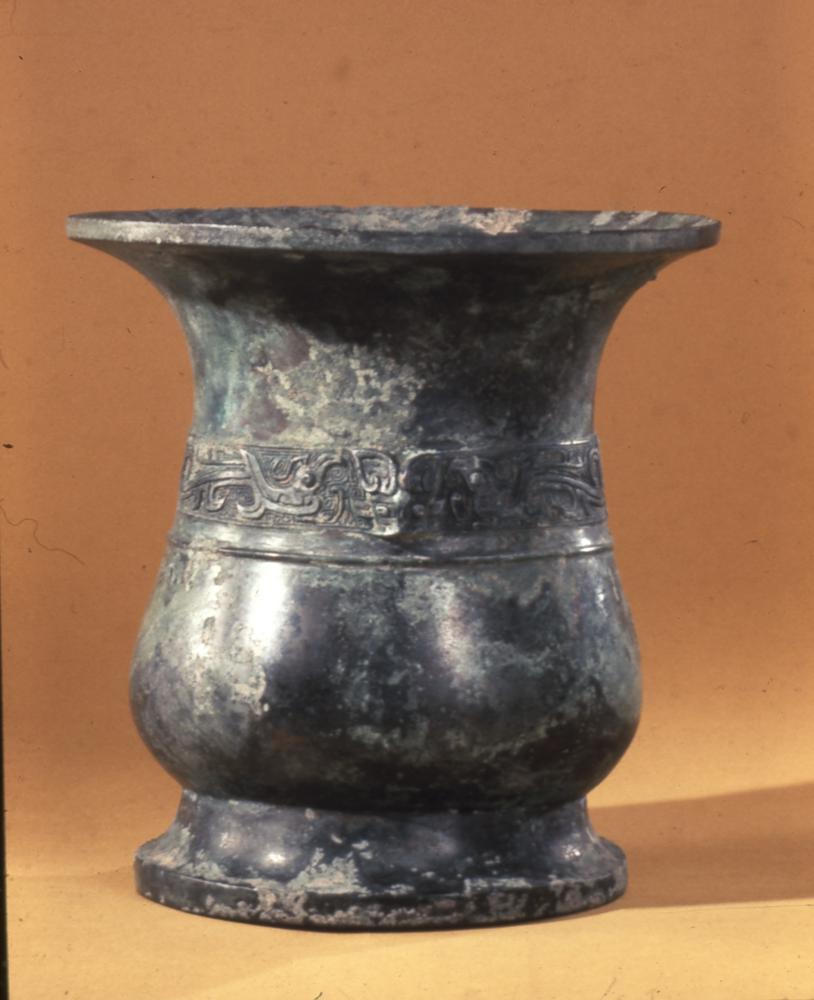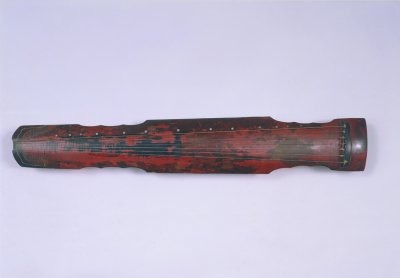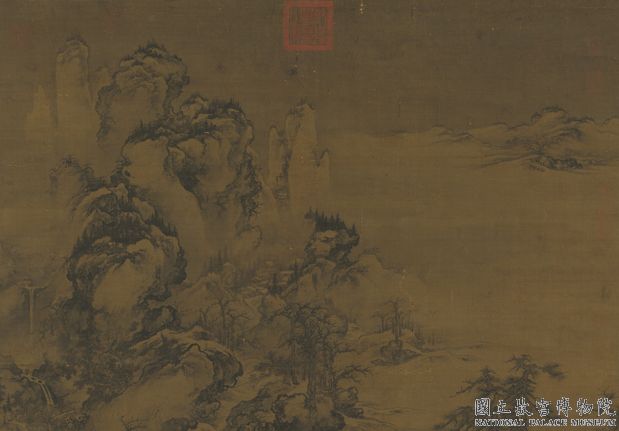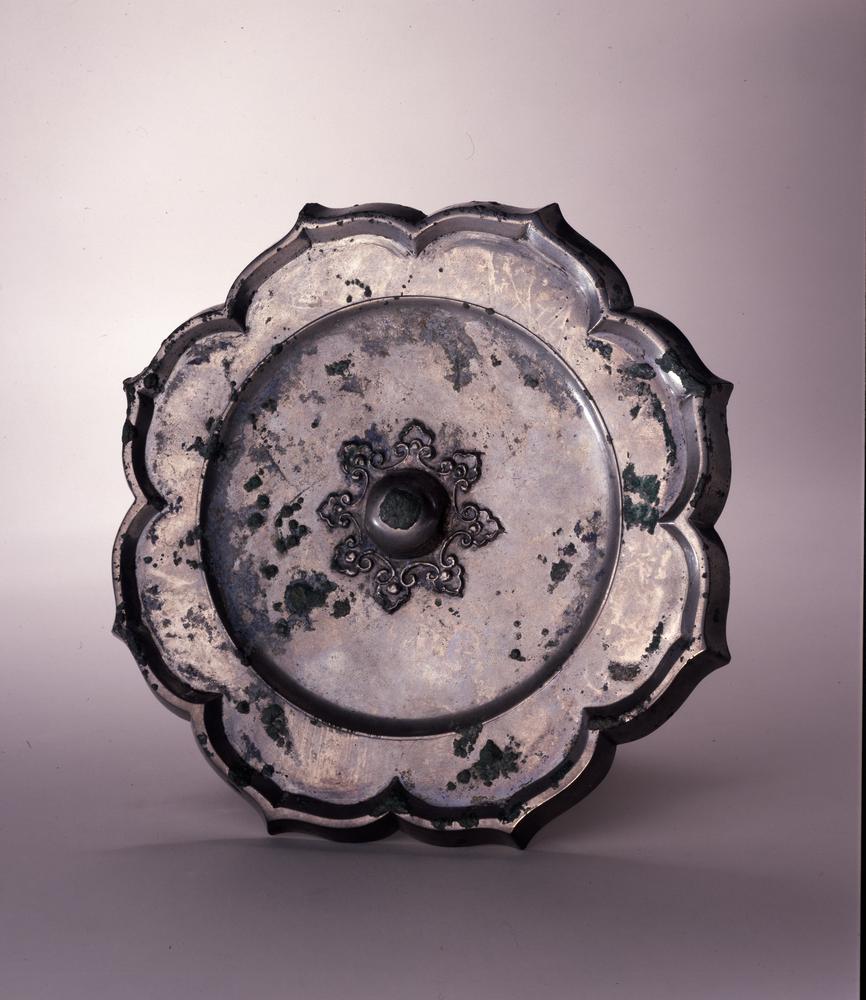Period:Tang dynasty Production date:801-850 (circa)
Materials:silk, 絲綢 (Chinese),
Technique:painted
Subjects:bodhisattva lotus vajra 菩薩 (Chinese) 蓮花 (Chinese) 金剛 (Chinese)
Dimensions:Height: 55 centimetres Width: 14.50 centimetres
Description:
Painted banner of a bodhisattva, depicted with a green body, holding a blue vajra in his right hands, a lotus stem in his left, and standing on a lotus. One of series of ten (see 1919,0101,0.101 and 102, which share many of the same features, including three-pronged tiara, striped dhoti, colourful flowered scarves). Ink and colour on silk. Tibetan inscription.
IMG
![图片[1]-banner; painting; 幡(Chinese); 繪畫(Chinese) BM-1919-0101-0.103-China Archive](https://chinaarchive.net/Tang dynasty/Paintings/mid_00014552_001.jpg)
Comments:EnglishFrom Whitfield 1982:This banner is the most impressive of the three (Pls. 46-48). The Bodhisattva, holding a small vajra in his right hand, faces the spectator squarely. The left hand, palm outwards, seems to caress one of the curving lotus stems at his side. Above him, instead of the hanging textile drape of the other banners, is a splendid floral border. His striped dhoti is smoothly wrapped around each leg, and a white-flowered scarf is tied in a generous knot on the right hip. The colour of his body is a greenish bronze. His eyes, quite horizontal, are almond-shaped, bright white with black pupils. This feature above all gives the figure its Indianizing appearance, and one might make the comparison with bronze figures with the eyes inlaid in silver (see, for instance, the eighth-century bronze Buddha from Phyang monastery, Ladakh, reproduced in Singh, 1968,p.53). Bright white is also used for the yajñopavīta, or sacrificial thread worn by the Bodhisattva-in sculpture these too on occasion may have been inlaid in silver. Such features support the theory that this group of paintings may be related to the art of Khotan. All three of these banners and presumably those in New Delhi from the same group differ in construction from the rest of the Dunhuang banners. They are on a grey silk with a balanced close weave, while the majority of the paintings are on a more open silk, with warp threads running in pairs. They are also much narrower than the usual width of the other banners, and both edges are hemmed with a strip of silk binding, instead of being merely painted with a dark brown pigment as is commonly seen. Finally, all three of these banners show a selvedge on the lower end. These facts seem to imply a different origin for the silk itself, and a different tradition of making the banners, the figures being at a right angle to the warp instead of in line with it. It does therefore seem possible, from technical as well as stylistic evidence, that these paintings were executed elsewhere and brought to Dunhuang, rather than being executed there under the influence of models from further west. It is very noticeable that none of the banners (including the group in New Delhi) has a cartouche for characters, even those that are in fact inscribed in Tibetan. ChineseFrom Whitfield 1982:此幡是同一系列的三件(圖46~48)中給人印象最深的作品。右手上放著小形的金剛杵,面向正前方。左手掌向前,手指執旁邊的蓮華莖。上方不像其他幡的幕,而是描繪著精美花紋的邊飾。從腰到腳的部分順滑的纏繞著細軟的布,身著布滿小花紋的天衣,鬆軟的繋在腰的右方。身軀被塗成青銅色,眼睛扁長呈杏仁形,純白眼底點著黑瞳。這種眼睛的表現方式更是印度式,可以與眼部嵌銀的金銅像(如,參照M.Singh;Himalayan Art.London,1968.p.53收錄的Phyang寺的8世紀金銅像)做比較。而且不僅是眼部,有的菩薩裝飾帶也是白色的,在雕刻作品中用嵌銀來表現那些部分也有很多例子。這種特徵成爲這一連貫的繪畫與和闐美術有關聯的有力證據。在新德里國立博物館的同一系列的幡恐怕也是那樣的,這三件幡的製作不同于敦煌其他幡。這三件採用經緯均勻質地細密的鼠灰色絹,而其他大部分的幡則採用只有兩根經線質地粗糙的絹。絹幅遠比其他幡狹窄。幡兩端的邊兒通常只是用黑褐色顔料繪出,而這三件則用細絹布縫的。而且此三件幡的任何一件,布的織邊在畫的下端。以上的不同點說明,不僅絹的生産地不同,幡的製作習慣也不同,菩薩像不是沿著經線,而是和經線成直角。因此,無論風格上還是技法上,與其說這三件幡是在敦煌受西方影響時製作的,還不如說在其他某一地方製作,帶到敦煌更爲妥當。這些一連竄的幡中(包括收藏在新德里國立博物館的),雖然有吐蕃文的記錄,但無一例有長方形題箋,這也是值得注意的。
Materials:silk, 絲綢 (Chinese),
Technique:painted
Subjects:bodhisattva lotus vajra 菩薩 (Chinese) 蓮花 (Chinese) 金剛 (Chinese)
Dimensions:Height: 55 centimetres Width: 14.50 centimetres
Description:
Painted banner of a bodhisattva, depicted with a green body, holding a blue vajra in his right hands, a lotus stem in his left, and standing on a lotus. One of series of ten (see 1919,0101,0.101 and 102, which share many of the same features, including three-pronged tiara, striped dhoti, colourful flowered scarves). Ink and colour on silk. Tibetan inscription.
IMG
![图片[1]-banner; painting; 幡(Chinese); 繪畫(Chinese) BM-1919-0101-0.103-China Archive](https://chinaarchive.net/Tang dynasty/Paintings/mid_00014552_001.jpg)
Comments:EnglishFrom Whitfield 1982:This banner is the most impressive of the three (Pls. 46-48). The Bodhisattva, holding a small vajra in his right hand, faces the spectator squarely. The left hand, palm outwards, seems to caress one of the curving lotus stems at his side. Above him, instead of the hanging textile drape of the other banners, is a splendid floral border. His striped dhoti is smoothly wrapped around each leg, and a white-flowered scarf is tied in a generous knot on the right hip. The colour of his body is a greenish bronze. His eyes, quite horizontal, are almond-shaped, bright white with black pupils. This feature above all gives the figure its Indianizing appearance, and one might make the comparison with bronze figures with the eyes inlaid in silver (see, for instance, the eighth-century bronze Buddha from Phyang monastery, Ladakh, reproduced in Singh, 1968,p.53). Bright white is also used for the yajñopavīta, or sacrificial thread worn by the Bodhisattva-in sculpture these too on occasion may have been inlaid in silver. Such features support the theory that this group of paintings may be related to the art of Khotan. All three of these banners and presumably those in New Delhi from the same group differ in construction from the rest of the Dunhuang banners. They are on a grey silk with a balanced close weave, while the majority of the paintings are on a more open silk, with warp threads running in pairs. They are also much narrower than the usual width of the other banners, and both edges are hemmed with a strip of silk binding, instead of being merely painted with a dark brown pigment as is commonly seen. Finally, all three of these banners show a selvedge on the lower end. These facts seem to imply a different origin for the silk itself, and a different tradition of making the banners, the figures being at a right angle to the warp instead of in line with it. It does therefore seem possible, from technical as well as stylistic evidence, that these paintings were executed elsewhere and brought to Dunhuang, rather than being executed there under the influence of models from further west. It is very noticeable that none of the banners (including the group in New Delhi) has a cartouche for characters, even those that are in fact inscribed in Tibetan. ChineseFrom Whitfield 1982:此幡是同一系列的三件(圖46~48)中給人印象最深的作品。右手上放著小形的金剛杵,面向正前方。左手掌向前,手指執旁邊的蓮華莖。上方不像其他幡的幕,而是描繪著精美花紋的邊飾。從腰到腳的部分順滑的纏繞著細軟的布,身著布滿小花紋的天衣,鬆軟的繋在腰的右方。身軀被塗成青銅色,眼睛扁長呈杏仁形,純白眼底點著黑瞳。這種眼睛的表現方式更是印度式,可以與眼部嵌銀的金銅像(如,參照M.Singh;Himalayan Art.London,1968.p.53收錄的Phyang寺的8世紀金銅像)做比較。而且不僅是眼部,有的菩薩裝飾帶也是白色的,在雕刻作品中用嵌銀來表現那些部分也有很多例子。這種特徵成爲這一連貫的繪畫與和闐美術有關聯的有力證據。在新德里國立博物館的同一系列的幡恐怕也是那樣的,這三件幡的製作不同于敦煌其他幡。這三件採用經緯均勻質地細密的鼠灰色絹,而其他大部分的幡則採用只有兩根經線質地粗糙的絹。絹幅遠比其他幡狹窄。幡兩端的邊兒通常只是用黑褐色顔料繪出,而這三件則用細絹布縫的。而且此三件幡的任何一件,布的織邊在畫的下端。以上的不同點說明,不僅絹的生産地不同,幡的製作習慣也不同,菩薩像不是沿著經線,而是和經線成直角。因此,無論風格上還是技法上,與其說這三件幡是在敦煌受西方影響時製作的,還不如說在其他某一地方製作,帶到敦煌更爲妥當。這些一連竄的幡中(包括收藏在新德里國立博物館的),雖然有吐蕃文的記錄,但無一例有長方形題箋,這也是值得注意的。
© Copyright
The copyright of the article belongs to the author, please keep the original link for reprinting.
THE END
![[Qing Dynasty] British female painter—Elizabeth Keith, using woodblock prints to record China from the late Qing Dynasty to the early Republic of China—1915-China Archive](https://chinaarchive.net/wp-content/uploads/2022/11/image-191x300.png)




